From very early historical times Indian royalty enjoyed the sport of hunting, or shikar as it was known, especially the pursuit of dangerous game such as tiger, bison and bear from a howdah on the back of specially trained elephants. Regal hunts were by all accounts gala affairs, with an extensive entourage of palace staff, high-ranking officials, tentage and furniture, opulent table fare, and of course shikaris, elephants and their mahouts. The practice appears to have reached almost fever pitch during the British Raj, with the influx of military and civil service personnel from England bringing with it the British penchant for field sports. The advantages of hunting tiger from an elephant were quickly realised by senior civil servants and high-ranking military officers alike, especially the added security of an elevated position in the event of a charge from wounded dangerous game.
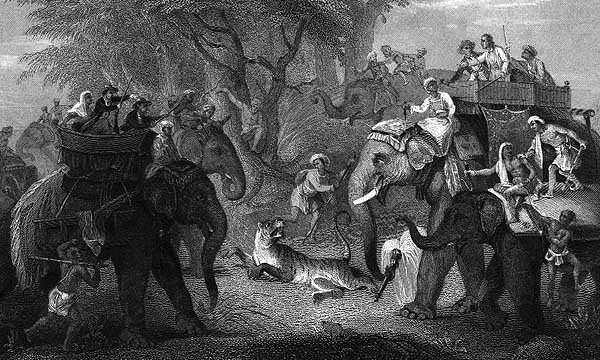
By all accounts this lofty sanction was far from secure and a range of emergency weapons has been carried in the howdah to be pressed into service in the not-unlikely event (apparently!) of a tiger attempting to leap onto the elephant to attack the hunters. No doubt swords and short jobbing-spears served this purpose well enough in the very early days however large-bore single-barrel or
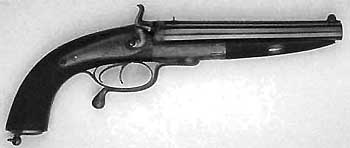 |
side-by-side double-barrelled pistols had taken over as outright favourites by the mid-1800s. Ranging from percussion dragoon-pistols or side-by-side muzzle-loaders early on, to break-open breech-loading handguns usually built on a rotary or snap-action under-lever design, these specialised heavy side-arms were usually sheathed on or |
in the howdah within easy reach of the occupant, or holstered on the hunter's person for instant accessibility in the gravest extreme!

In those days, there were no illusions about the most effective projectiles for close-quarter conclusions with an angry tiger. The bigger the bullet, the better! At such short ranges trajectory was immaterial and penetration rarely limiting, hence the powder-charge was of secondary importance to bullet diameter. Common chamberings ranged from the various .450s, .455s and .476s through the .577 Revolver and .577 Snider, right up to the short 16-bore! In a hand-gun, the latter would have been a handful indeed!
Less common, but nonetheless effective as a close range tiger-stopper, was the light, handy, short-barrelled bore-rifle. These specialist double-guns were designed for spherical ball or a short conical bullet, and were chambered for either a brass or paper-case cartridge. The crucial quick-handling qualities and capacity for a fast follow-up shot were enhanced by the side-by-side coach-gun design and total weight rarely exceeding 8 lbs. Powder-charges were relatively light in order to minimise recoil, although admittedly "recoil is insignificant when there is a tiger on the head of your elephant", as the Maharajah of Cooch Behar was once heard to remark!

The howdah rifle presented here bears the inscription "W & J Kavanagh" on the lock-plates, having been built by the very talented Irish gun-making family by that name. The top rib carries the firm's address: "12 Dame Street, Dublin". We know that William Kavanagh originally set up shop at Lower Ormand Quay around 1817, and moved up to the Dame Street foundry in 1821 where the company continued to trade for over 100 years! Like the rib and locks of this gun, trade labels from the second half of the 19th Century read "W & J Kavanagh", however the Dublin City Directory of 1850 listed only William Kavanagh as a gun-maker and no-one by the name of J. Kavanagh was listed in the trade. We can surmise that he joined the firm some time after 1850, a younger brother perhaps? Later guns made around the turn of the century were marked "Wm Kavanagh & Son", implicating the next generation of this famous gun-making dynasty.
The Kavanagh firm hung its shingle alongside other well-known Dublin gun-makers, the most notable being William & John Rigby of Suffolk Street, and William Trulock of several addresses in the Dublin gun-making quarter including Dame Street. The well-respected London maker, Stephen Grant, apprenticed to William Kavanagh in his youth.
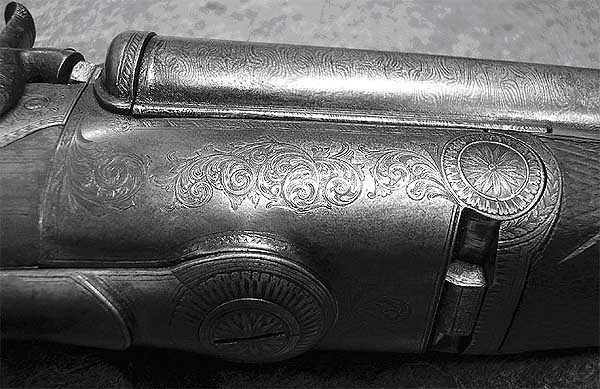
The rifle before us is an early side-by-side double-barrelled hammer gun built on the Jones-patent rotary under-lever action. While this might suggest a date of manufacture some time after 1859, a number of other features of this remarkable vintage firearm speak to us of a far more interesting origin! Neatly-executed and barely-visible metal patches dove-tailed into the tops of the chambers indicate that the gun was converted to central-fire from the earlier pin-fire ignition system. The relatively thin chamber walls and the shallow fences provide further evidence that the firearm is a
|
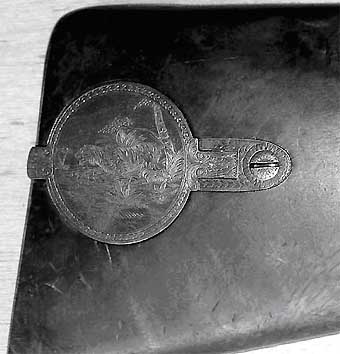 |
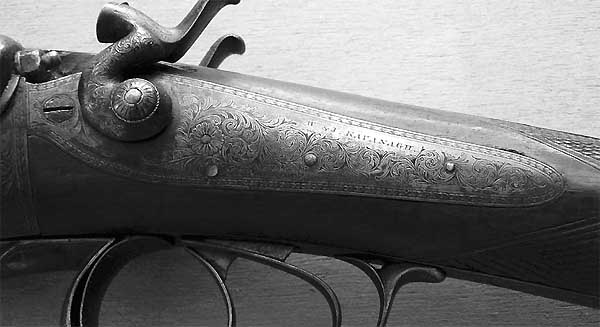
The short barrels measure just under 22 inches, with their wide 4-groove rifling making almost half a turn in that length for perhaps a 1:48 twist rate. The rifling lands are a little steeper on the leading edge and slightly rounded on the trailing edge, giving the impression of an intriguing ‘ratchet’ effect. The top rib is equipped with three folding leaves ambitiously marked for 100, 200 and 300 yards, with a moderate front bead measuring 80 thou in diameter. The absence of a standing leaf would have proven very handy for point-blank personal defence when the tiger was in dangerously close proximity to the hunter! This firearm is obviously intended to be pointed at the adversary at times, rather than aimed, and perhaps even 'prodded' at the point of discharge in dire circumstances!

Information on the early 12-bore ball cartridge for which this double-gun was probably intended is rather sketchy in the historical literature. According to W.W. Greener’s tome, the most likely
|
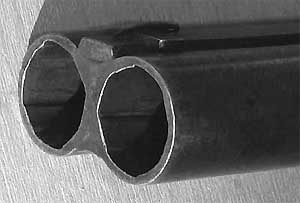 |
shikar, and was probably rather light even as the primary arm in a howdah. As well as tiger and bear, buffalo and gaur were common quarry, and a rhinoceros or wild bull elephant in 'must' could not be ruled out.

For such game, heavy bore-guns from the 5-dram No.12 up to the 10-dram No.8 were sine qua non during the mid to late 1800s. Double express rifles from .450 to .577 would soon become popular as bore-guns gradually faded from the scene, and although the 'Paradox' or 'Jungle Guns' were to enjoy brief popularity around the turn of the century, the various cordite express rifles would eclipse them all by the beginning of the Kaiser's War.
Like the better-known howdah pistols, however, this stumpy 12-bore 3-dram rifle would have possessed all the short-range power required to dislodge an angry tiger from the elephant's head, at distances measured in feet and sometimes barely inches! Sadly, the attempts of modern man to distance himself from the soil have relegated many marvellous artefacts like this howdah rifle to insipid curiosity, and as a result the majority are now lost. For the avid hunter/collector, however, merely shouldering this surviving example conjures up the sights, smells, and excitement of shikar in that distant land so long ago!